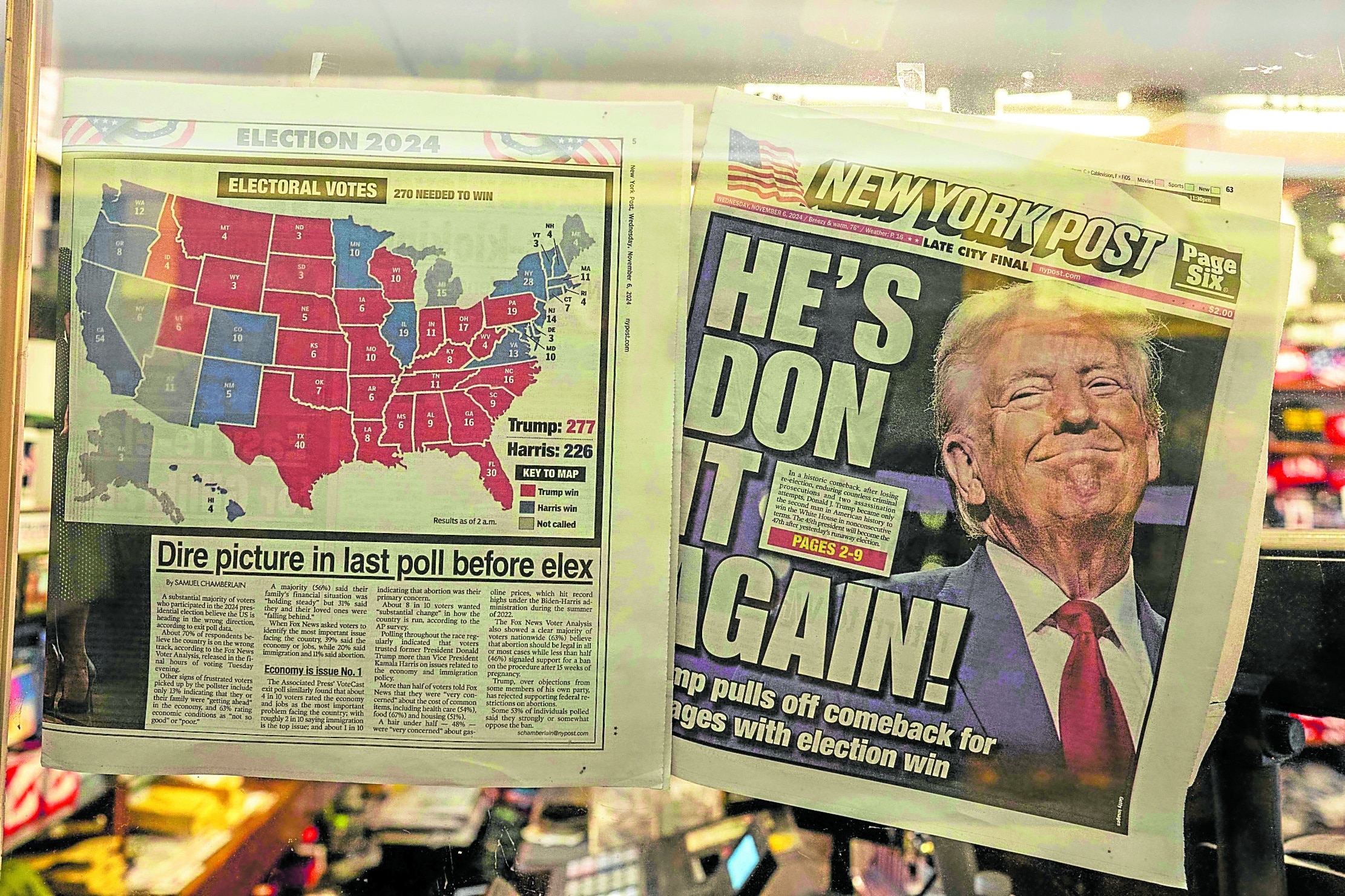
WHAT CLOSE FIGHT? The NewYork Post banners Donald Trump’s sweeping victory on Wednesday that clinched him a second term as US president after four years. —AFP
WASHINGTON — Opinion polls underestimated the level of Donald Trump’s support for the third US presidential election in a row, predicting a neck-and-neck race with Kamala Harris when in the end the Republican edged the vice president across battleground states.
Trump’s win involved surging support in a number of demographics and regions, but experts said pollsters failed to accurately predict races in states where the results differed significantly from the last election in 2020.
Article continues after this advertisement“They did fine in battlegrounds, but… they failed to provide the essential information that Trump was surging across the board,” said Michael Bailey, a professor of political science at Georgetown University.
FEATURED STORIES GLOBALNATION Better for undocumented Filipinos in US to leave than be deported – envoy GLOBALNATION Marcos order banning Pogos finally out: All for national security GLOBALNATION Experts: Trump’s pitch on economy swayed 72M votersMore than 90 percent of US counties voted in higher numbers for the Republican billionaire than they did in 2020, according to The New York Times.
Predicted marginsOverall, the polls had predicted razor-thin margins in races in the seven battleground states that decide close US elections. As of Wednesday, Trump was projected to win five of those states by between 1 and 3 percentage points.
Article continues after this advertisementREAD: Trump’s decisive victory in a deeply divided nation
Article continues after this advertisementThe former president was well on his way to sweeping all seven states, according to those projections.
Article continues after this advertisement“Trump may have been mildly underestimated but I think the polls ended up doing pretty well, collectively—this was not a huge miss,” said Kyle Kondik, a political analyst at the University of Virginia.
“The polls suggested Trump had a decent chance to win, and he won.”
Article continues after this advertisement Small marginsThe pollsters’ performance was under the microscope this year, after two big misses in succession: they had failed to anticipate Trump’s victory in 2016 and had overestimated the margin by which President Joe Biden won against him in 2020.
“Trump was underestimated by about 2 points this time around” in key states, said Pedro Azevedo, head of US polling at AtlasIntel.
In Pennsylvania, the latest polling average from RealClearPolitics put the Republican in the lead by 0.4 percentage points. As of Wednesday, he was ahead by 2 points.
In North Carolina, polls predicted a 1.2-point margin for Trump, and he won by 3 points over Harris.
In Wisconsin, the vice president was given a 0.4-point lead, but the projected results showed Trump leading the count by 0.9 points.
Unable to adjustThe main problem has not changed since Trump’s arrival on the US political scene about a decade ago: a fringe of his electorate refuses to take part in opinion polls, and firms have failed to be able to accurately gauge their impact.
In the most recent polls conducted by The New York Times with Siena College, “white Democrats were 16 percent likelier to respond than white Republicans,” NYT data analyst and polling guru Nate Cohn wrote two days before the election.
That disparity had grown over the course of the 2024 campaign, he added.
Although pollsters like The New York Times/Siena tried to compensate for these flaws with statistical adjustments, it was clearly not enough.
“It is apparent that polls significantly underestimated Trump’s growth among Hispanic voters,” said Azevedo, pointing to Trump’s larger-than-expected victories in Nevada and Florida.
“This is also the case among white voters,” he said, adding that while most polls expected Harris to “improve her margins” in this demographic, Trump outperformed the polling and ran up his numbers in rural areas.
Late decidersIowa was a prime example of this, with a poll three days before Election Day giving Harris a three-point victory in the solidly Republican state. In the end, Trump won it comfortably by 13 points, Azevedo said.
J. Ann Selzer, the author of that inaccurate Iowa poll, said the difference could have been made by late-deciding voters.
“The late deciders could have opted for Trump in the final days of the campaign after interviewing was complete,” she told the Des Moines Register newspaper.
Subscribe to our daily newsletter
“The people who had already voted but opted not to tell our interviewers for whom they voted could have given Trump an edge.”jili777
READ NEXT What went wrong for Kamala? Top PNP execs suspended over alleged Pogo raid extortion EDITORS' PICK Jayson Castro wins third PBA Finals MVP for TNT at 38 Pagasa: New LPA may enter PAR within 24 hrs Global food prices reach 18-month high — FAO LIVE UPDATES: Typhoon Marce Marcos: Heed ‘Yolanda’s’ ‘payload of lessons’ 1-Pacman nominee Milka Romero, sister Mandy nurturing rise of Capital1 MOST READ PH affirms maritime zones, angering China Sue Ramirez, Dominic Roque spotted together in Siargao PH right not to let US join in West Philippine Sea resupply mission – NSC Experts: Trump’s pitch on economy swayed 72M voters Follow @FMangosingINQ on Twitter --> View comments


